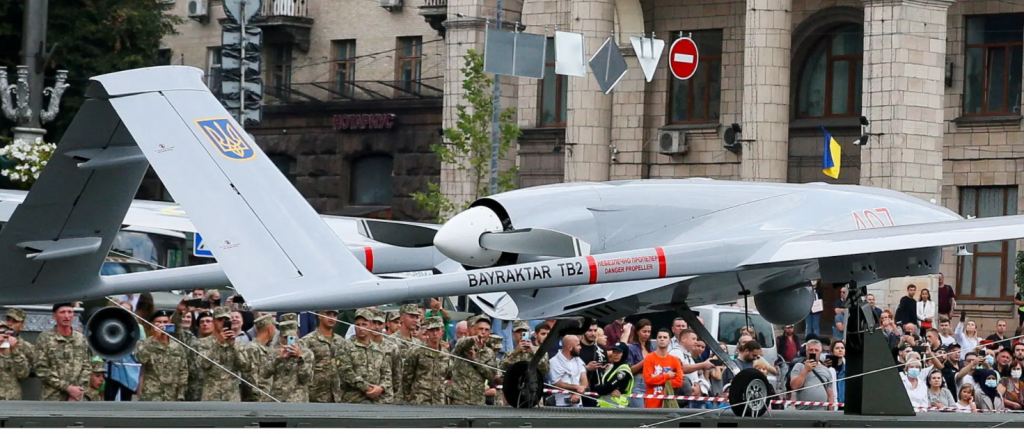A video posted toward the end of February on the Facebook page of Valerii Zaluzhnyi, the commander-in-chief of Ukraine’s armed forces, showed grainy aerial footage of a Russian military convoy approaching the city of Kherson. Russia had invaded Ukraine several days earlier, and Kherson, a shipbuilding hub at the mouth of the Dnieper River, was an important strategic site. At the center of the screen, a targeting system locked onto a vehicle in the middle of the convoy; seconds later, the vehicle exploded, and a tower of burning fuel rose into the sky. “Behold the work of our life-giving Bayraktar!” Zaluzhnyi’s translated caption read. “Welcome to Hell!”
The Bayraktar TB2 is a flat, gray unmanned aerial vehicle (U.A.V.), with angled wings and a rear propeller. It carries laser-guided bombs and is small enough to be carried in a flatbed truck, and costs a fraction of similar American and Israeli drones. Its designer, Selçuk Bayraktar, the son of a Turkish auto-parts entrepreneur, is one of the world’s leading weapons manufacturers. In the defense of Ukraine, Bayraktar has become a legend, the namesake of a baby lemur at the Kyiv zoo, and the subject of a catchy folk song, which claims that his drone “makes ghosts out of Russian bandits.”
In April, 2016, the TB2 scored its first confirmed kill. Since then, it has been sold to at least thirteen countries, bringing the tactic of the precision air strike to the developing world and reversing the course of several wars. In 2020, in the conflict between Azerbaijan and Armenia over the enclave of Nagorno-Karabakh, Azerbaijan’s dictatorial leader, Ilham Aliyev, used the TB2 to target vehicles and troops, then displayed footage of the strikes on digital billboards in the capital city of Baku.
The TB2 has now carried out more than eight hundred strikes, in conflicts from North Africa to the Caucasus. The bombs it carries can adjust their trajectories in midair, and are so accurate that they can be delivered into an infantry trench. Military analysts had previously assumed that slow, low-flying drones would be of little use in conventional combat, but the TB2 can take out the anti-aircraft systems that are designed to destroy it. “This enabled a fairly significant operational revolution in how wars are being fought right now,” Rich Outzen, a former State Department specialist on Turkey, told me. “This probably happens once every thirty or forty years.”
I spoke with Bayraktar in March, via video. He was in Istanbul, at the headquarters of his company, Baykar Technologies, which employs more than two thousand people. When I asked him about the use of his drones in Ukraine, he told me, “They’re doing what they’re supposed to do—taking out some of the most advanced air-defense systems and armored vehicles in the world.” Bayraktar, who is forty-two years old, has a widow’s peak, soft eyes, and a slightly off-center nose. He was flanked by scale models of new drones, mounted on clear plastic stands, which he displayed to me with the unconcealed pride of an aviation geek. “Any U.A.V. built today to fly, I pilot it myself, because I, like, love it,” he told me. Bayraktar, who has more than two million Twitter followers, uses his account to promote youth-education initiatives, celebrate Turkish martyrs, and post pictures of new aircraft designs. “Some people here consider him like Elon Musk,” Federico Donelli, an international-relations researcher at the University of Genoa, told me.
In May, 2016, Bayraktar married Sümeyye Erdoğan, the youngest daughter of Recep Tayyip Erdoğan, Turkey’s President. Erdoğan is the leader of a political Islamist movement that, the analyst Svante Cornell has written, wishes “to build a powerful, industrialized Turkey that serves as the natural leader of the Muslim world.” Turkey’s arms industry has grown tenfold in the past twenty years, and most of the country’s military equipment is now manufactured locally. “The Bayraktars, and particularly the TB2s, have turned into the flagship of the Turkish defense industry,” Alper Coşkun, a former Turkish diplomat, told me.
Turkey borders Iran, Iraq, Syria, Armenia, Georgia, and the European Union, and it faces Russia across the Black Sea. Donelli told me that the shifting allegiances and complex politics of the region reminded him of Europe in the days before the First World War. “In Bayraktar, they have a kind of genius who can change the historical path of Turkey,” Donelli said.
Erdoğan has held power since 2003. During that time, he has seized control of the courts and the press, amended the Turkish constitution, and advocated for a return to traditional roles for women. Journalists critical of the Erdoğan regime have been beaten with baseball bats and iron rods, and opposition activists have been sentenced to decades in prison. But Turkey’s economy is stagnating, and its inflation rate rose to seventy per cent during the past twelve months. In 2019, Erdoğan’s party lost the mayoralty of Istanbul, which it had held since the nineteen-nineties. The TB2 is a spectacular propaganda machine, and Erdoğan has used its success to promote his vision for Turkish society. As Bayraktar told me, “In this day and age, the biggest change in our lives is driven by technology—and who drives the changes? The ones who create technology.”
newyorker.com
